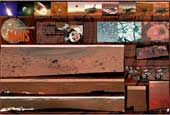
 |
|
|
|
Everyone knows that Venus goes around the Sun, and that the Moon is a quarter of a million miles away from Earth. But did you ever bother to check for yourself that these taken-for-granted assertions are actually true, and how do you do it? This delightful book by John D Clark is really a breath of fresh air in popular science publishing, taking us back to astronomical basics and starting from the beginning. With the help of very clear diagrams and graphics, the text takes you through fully-worked examples, asking questions about sizes, distances and motions within the Solar System. It then sets about, always with simple, readily available and inexpensive equipment, to show you how to answer those questions for yourself. You’ll need a good understanding of maths, or at least a willingness to learn about some of the tougher maths. GCSE level algebra and geometry will do for most of it, but there are occasional appearances by some more complex manipulations like integration, too. For those a bit mathematically rusty, a handy geometry and statistics refresher is included at the back! The great achievement of John Clark’s book is that it not only gets us to question what we take for granted, but also manages to go about finding the answers in a friendly, self-effacing sort of tone throughout. This makes the reader far more comfortable and, ultimately, prepared to try and understand what might, if it were presented in the usual dry way, be an intimidating subject. Overall, this is a very worthwhile text that, without resorting to expensive gear, teaches good scientific observation, measurement and mathematics. I do think a couple of the observing methods could be simpler, and the maths made a little more appealing to those who don’t practice it every day, but that said, this book nicely stretches your ability and teaches something very useful at the same time. This is the kind of thing we need more of! John Rowlands |
|
|
|
2009 Yearbook This 132-page special edition features the ultimate observing guide for 2009, a review of all the biggest news stories of 2008, in depth articles covering all aspects of astronomy and space missions for 2009, previews of International Year of Astronomy events and much, much more. This 132-page special edition features the ultimate observing guide for 2009, a review of all the biggest news stories of 2008, in depth articles covering all aspects of astronomy and space missions for 2009, previews of International Year of Astronomy events and much, much more.Infinity Rising  This special publication features the photography of British astro-imager Nik Szymanek and covers a range of photographic methods from basic to advanced. Beautiful pictures of the night sky can be obtained with a simple camera and tripod before tackling more difficult projects, such as guided astrophotography through the telescope and CCD imaging. This special publication features the photography of British astro-imager Nik Szymanek and covers a range of photographic methods from basic to advanced. Beautiful pictures of the night sky can be obtained with a simple camera and tripod before tackling more difficult projects, such as guided astrophotography through the telescope and CCD imaging.Exploring Mars  Astronomy Now is pleased to announce the publication of Exploring Mars. The very best images of Mars taken by orbiting spacecraft and NASA's Spirit and Opportunity rovers fill up the 98 glossy pages of this special edition! Astronomy Now is pleased to announce the publication of Exploring Mars. The very best images of Mars taken by orbiting spacecraft and NASA's Spirit and Opportunity rovers fill up the 98 glossy pages of this special edition!Mars rover poster  This new poster features some of the best pictures from NASA's amazing Mars Exploration Rovers Spirit and Opportunity. This new poster features some of the best pictures from NASA's amazing Mars Exploration Rovers Spirit and Opportunity. |
||||||||||||||||||||||||